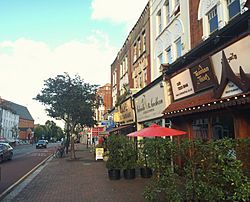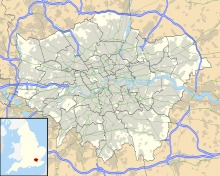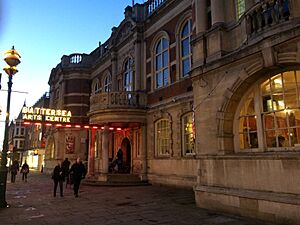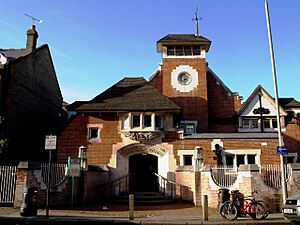Lavender Hill facts for kids

View of restaurants on the central section of Lavender Hill, looking east
|
|
| Former name(s) | Lavender Place (eastern end) |
|---|---|
| Part of | A3036 |
| Maintained by | Wandsworth Borough Council |
| Length | 0.8 mi (1.3 km) |
| Location | London, United Kingdom |
| Postal code | SW11 |
| Nearest rail station | Clapham Junction Railway Station |
| Coordinates | 51°27′54″N 0°09′29″W / 51.46508°N 0.15802°W |
| West end | Clapham Junction |
| East end | Wandsworth Road |
| Other | |
| Known for |
|
Lavender Hill is a well-known street in Battersea, south London. It's a busy place with lots of shops and homes, located close to Clapham Junction. The street is part of the A3036 and stretches for about 1.3 kilometers. It gets its name from the gentle hill it climbs.
Contents
Exploring Lavender Hill's Past
How Lavender Hill Got Its Name
The name 'Lavender Hill' has been around for a long time. The first mention of it was in 1774. Someone advertising for a lost pony said it went missing from 'a Field on Lavender-Hill'. This shows the name was already common back then.
The name comes from the lavender plants that used to grow here. The area had good soil and fresh air. This made it perfect for growing lavender for sale.
The first building named after lavender was Lavender Hall in 1790. Over time, other streets like Lavender Gardens and Lavender Walk also got their names from this history.
Victorian Era: A Time of Growth
The opening of Clapham Junction railway station in 1863 changed Lavender Hill a lot. Many houses and big buildings were built. It quickly became a busy area for shopping and living.
By 1885, the famous Arding & Hobbs department store was built. It was the biggest store south of the River Thames. The grand Church of the Ascension was also built in 1883.
Battersea Central Library opened in 1890. It was designed by Edward William Mountford, who also designed the Old Bailey. The library was very popular and had new parts added later.
Battersea Town Hall opened in 1893. This large building was the main office for the area. Today, it is known as the Battersea Arts Centre. It is a major place for arts and performances.
Lavender Hill Today
Shopping and Eating on Lavender Hill
Lavender Hill is now a lively street with many shops and restaurants. There are about 200 different places to visit. The Lavender Hill Traders' Association even holds a yearly Lavender Festival. This event helps show off the street as a fun place to shop and visit.
The part of the street closest to Clapham Junction station is very busy. Here you'll find the large Arding & Hobbs building, which is now a Debenhams department store. There are also many restaurants and cafes, including a Pizza Express. You can also find a big Asda supermarket and a Whole Foods Market.
In the middle of Lavender Hill, you'll see many estate agents. This section also has the main police station for Battersea. The Battersea Arts Centre is also located here. This area is popular for its many restaurants and bars.
The eastern end of the street has smaller shops like Sainsbury's and Tesco. This part of Lavender Hill has many independent businesses. You can find shops for cycling, music, and home design. Many cafes, like Caffè Nero, also have outdoor seating here.
In 2011, the local council improved the street. They made the pavements wider and added new streetlights. This made the area nicer for shoppers and walkers.
Businesses and Homes
While Lavender Hill has many homes, it also has office spaces. The Battersea Business Centre is a good example. It provides workspace for about 140 businesses. It used to be an old paper mill.
Most of the old industrial areas have now become homes. This shows how the area has changed over time.
Lavender Hill is surrounded by a busy residential area. Many of the homes are old Victorian buildings. You can find hotels like Travelodge and Premier Inn nearby.
Getting Around Lavender Hill
Public Transport Options
Lavender Hill is easy to reach by public transport. The western end is very close to Clapham Junction railway station. This is one of the busiest train stations in Europe.
The eastern end of the street is a short walk from other stations. These include Wandsworth Road railway station and Queenstown Road railway station. You can also reach Clapham Common Underground station easily.
In the 1890s, trams ran along Lavender Hill. These trams connected different parts of London. The tram lines were removed in the 1950s.
Today, several bus services use Lavender Hill. These buses follow similar routes to the old trams. There is even a special bus lane for eastbound traffic.
You can also find Santander Cycles docking stations near Lavender Hill. These allow you to rent bikes to explore the area.
On 10 August 2017, a bus left the road and collided with a shopfront on the street. Ten people were injured in this accident. The driver was described as having lost consciousness at the time.
Images for kids








